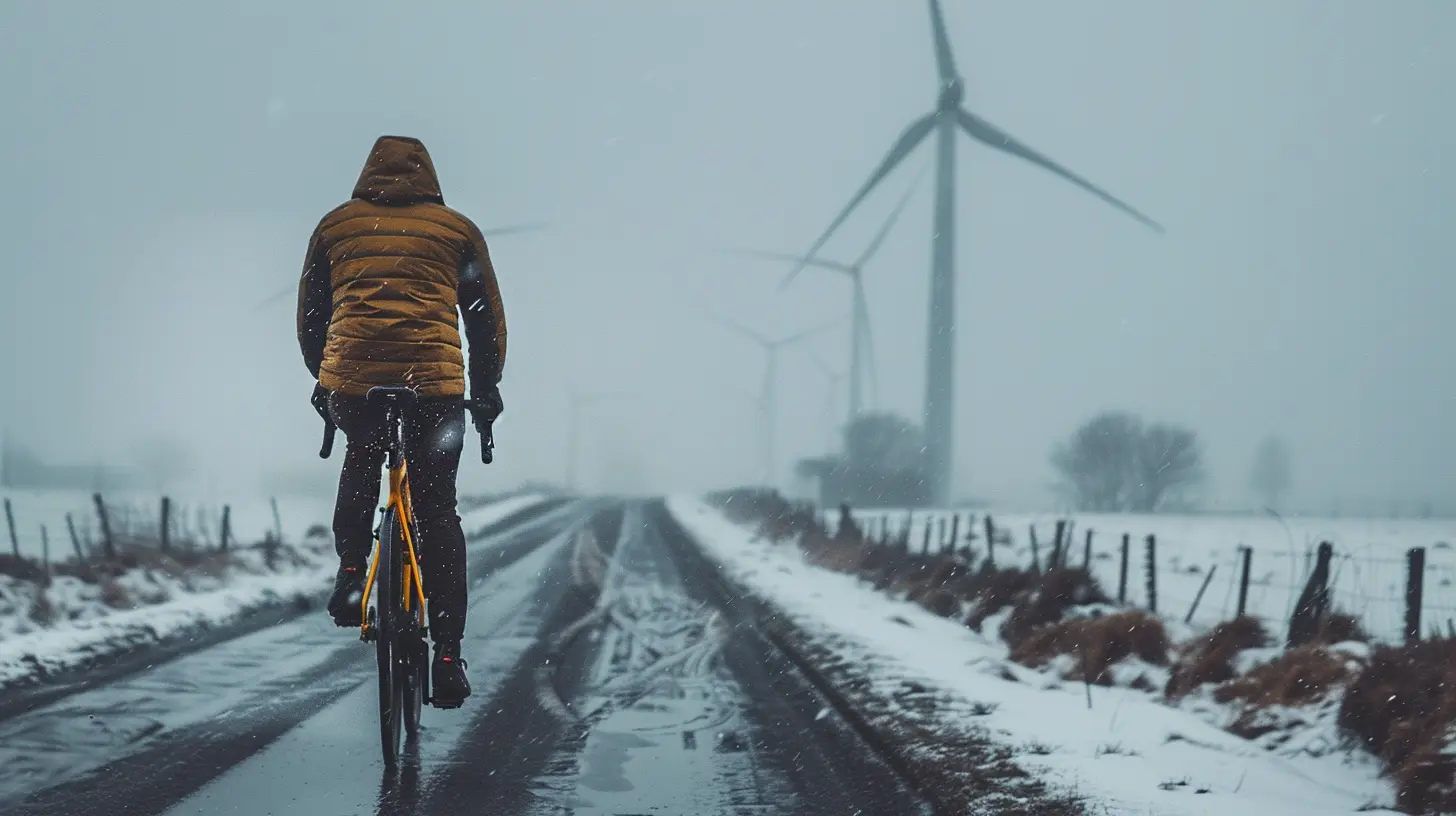How to Deal with Windy Conditions on Your Cycling Route
21 August 2025
Let’s face it—riding your bike in windy conditions can feel downright brutal. One moment you’re cruising along, and the next, it’s like someone hit the brakes—only it’s the wind pushing right against your chest. Whether you're a weekend road warrior or a daily commuter, riding in the wind can zap your energy, mess with your rhythm, and leave you mentally drained. But guess what? With the right mindset and a few smart techniques, wind doesn’t have to ruin your ride.
In this guide, we're going to talk all about how to deal with windy conditions on your cycling route. We'll go into practical strategies, gear tweaks, and mental tricks that’ll help you pedal through those tough headwinds and gusty days like a champ.
Why Wind Feels Like Your Worst Enemy on the Road
Ever had one of those days where nothing feels quite right while riding? Your legs are screaming, your speed drops for no clear reason, and it feels like you're going uphill even on flat terrain. Chances are, you're battling the wind.Wind resistance is one of the biggest energy sucks in cycling. Unlike climbs, which end eventually, wind can be relentless and unpredictable. And unlike rain or heat, wind messes with your balance and makes it harder to maintain a straight line. It's invisible, sneaky even, but oh-so powerful.
So yeah—it’s not just in your head. Riding in wind really is harder.
Understanding the Different Types of Wind You’ll Face
Before we dive into how to deal with it, let’s talk about the types of wind you might run into on a ride:1. Headwinds
This is the big mean one. A headwind blows directly against you as you ride. It slows you down and makes every pedal stroke a struggle.2. Tailwinds
The wind angels! These push you along from behind. Almost feels like you grew wings. Enjoy it while it lasts.3. Crosswinds
This is where things get tricky. Crosswinds push from the side, making it hard to steer and sometimes even dangerous—especially around open fields or bridges.4. Gusty Winds
These come and go unpredictably. One second, all’s calm. The next—BOOM—you’re hit with a blast that almost knocks you off the saddle.Understanding what you’re up against helps shape how you prepare and ride.
Gear Up: Choosing the Right Equipment for Windy Rides
The gear you use can make a noticeable difference in how well you handle wind. Here’s what to think about:🧢 Aerodynamics Matter
If the wind is against you, every bit of drag slows you down. Wear tight-fitting clothes, an aerodynamic helmet, and avoid anything flappy like a loose jacket. Think like a bullet slicing through the wind.🚴♂️ Deep-Section Wheels? Maybe Not...
While deep-rim wheels can be faster in calm conditions, they act like sails in strong crosswinds. If you’re riding where winds are unpredictable, consider using shallower rims—more control, less drama.👁️ Eye Protection
Wind can kick up dust, insects, and debris—don’t let it catch you off guard. Grab a good pair of wraparound sunglasses or cycling glasses.🧤 Gloves and Layers
Wind can suck the warmth out of you. Dress in layers, especially on longer rides. Windproof gloves and a vest can keep you from freezing, even when the temperature’s mild.
Riding Techniques That Can Save Your Legs (And Sanity)
Gear’s important, but how you ride matters just as much. Let’s look at some smart riding strategies for dealing with windy conditions.1. Tuck In and Lower Your Profile
Drop down into the drops (that curved part of your handlebars) to get into a more aerodynamic position. The less wind your body catches, the easier it’ll be to move forward.Think of it like cutting through water—you want to be a streamlined dolphin, not a flailing octopus.
2. Choose a Wind-Friendly Route
If you can plan your ride, do it smartly. Look for routes with some natural wind protection like trees, buildings, or hills. Avoid open plains if you can because they’re like wind tunnels.Also, try riding into the headwind on your way out and enjoy a tailwind pushing you home. Trust me, it’s a game-changer for morale.
3. Work with the Group
If you’re riding with others, draft smart. Riding behind someone reduces wind resistance by up to 30%. Take turns at the front, communicate, and form a tight line. It's teamwork in action.In crosswinds, stagger your position slightly to the side of the rider in front—this is called “echelon” formation. It’s not just pro talk; it works.
4. Adjust Your Effort, Not Your Speed
Don’t obsess over your speed. Windy conditions naturally slow you down. Instead, aim to keep a steady effort. Use a power meter or heart rate monitor if you have one. Your body doesn’t care what the speedometer says—it cares about effort and fatigue.Riding into the wind at full effort just to keep up your average speed? That’s a one-way ticket to burnout city.
Mental Strategies: Winning the Mind Game
Let’s not sugarcoat it—wind can be mentally exhausting. But cycling isn’t just about physical strength, right? It’s a mental sport too.🎧 Set the Mood
Create a playlist or download a podcast that keeps you motivated. It helps distract you from the grinding noise of wind in your ears.🧠 Reframe the Challenge
Instead of groaning every time the wind howls, flip the script. Think of it as resistance training for your legs or mindfulness training for your patience. “If I can ride in this, I can ride in anything.”🗣️ Talk to Yourself
No, you’re not going nuts. Positive self-talk works. Tell yourself: “I’m stronger than this wind” or “Every pedal stroke is progress.” It pumps you up more than you’d think.Quick Tips for Dealing with Specific Wind Conditions
Let’s break it down even more:💨 Headwind Tips
- Get low and aero- Shift into an easier gear and maintain cadence
- Stay steady, stay calm
🌀 Crosswind Tips
- Relax your grip—don’t fight the wind- Lean slightly into the wind for balance
- Watch for passing trucks or gaps in shelter—they create sudden gusts
🏁 Tailwind Tips
- Time for a little fun! Increase speed if you want, or rest your legs- Keep control—tailwinds can make it easy to go too fast without realizing it
Nutrition and Hydration Still Matter—Even in Wind
Windy rides, especially headwinds, demand more from your body. You're working harder, even if it doesn't always feel like it. So:- Sip water regularly (wind dries you out!)
- Fuel up with snacks on rides over an hour
- Consider an electrolyte drink if it's warm or the ride is long
Ignoring nutrition just adds more stress to an already challenging ride.
Is It Ever Too Windy to Ride?
Great question. And the answer is: sometimes, yes.If winds are over 40-50 mph (65+ km/h), it’s probably not worth it. Risk of being blown into traffic, debris in the air, or struggling to stay upright? Nope, not worth the danger.
When in doubt, swap your outdoor ride for a turbo trainer session indoors. Better safe than sorry.
Building Wind Tolerance Takes Time
The first few times you ride in strong wind, it can feel completely defeating. But like anything else, it gets easier with practice. Your body gets stronger, your skills sharpen, and your mind becomes more determined.Stick with it. You’re not just becoming a better cyclist—you’re becoming a tougher one, too.
Final Thoughts
We all love those perfect, sunny, windless days on two wheels. But the truth is, that’s not always what we get. Windy rides come with the territory, and learning how to deal with windy conditions on your cycling route is a skill worth mastering.Keep your spirits up, your body steady, and your mind focused. The wind might knock you back, but it’ll never keep you down.
So next time the forecast says breezy, you’ll say—bring it on.
all images in this post were generated using AI tools
Category:
CyclingAuthor:

Frankie Bailey
Discussion
rate this article
1 comments
Faith Hill
Embrace the breeze, let it guide your wheels to freedom.
September 14, 2025 at 12:54 PM

Frankie Bailey
Thank you! Embracing the wind can definitely enhance the cycling experience and teach us valuable skills.


